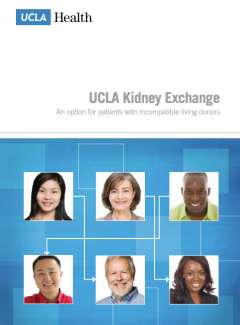Living Donor Kidney Transplant
Find your care
We have one of the highest volume kidney transplant programs in the country, with outstanding patient outcomes. To learn more, call 310-825-6836.
If you are a kidney donor, please contact the Living Donor Line at 866-672-5333.
UCLA is one of the leading programs on the West Coast offering living donor kidney transplantation for adult kidney transplant and pediatric kidney transplant patients. This procedure is one way our commitment to innovation, research and trials makes transplant available to more people. Read about finding a living donor.
What is a living donor kidney transplant?
For a living donor kidney transplant, surgeons remove one kidney from a living donor and transplant it in the recipient.
The living donor usually is a relative or close friend, but anyone who is medically healthy can donate a kidney. There are four types of living kidney donation: direct donation, paired exchange donation, non-directed donation, and advanced donation. After the transplant, both donor and recipient can function normally with one kidney each.
Advantages of living donation
The greatest advantage of living donation is that the kidney tends to have more immediate function, lasts longer than a kidney from a deceased donor and greatly decreases the amount of time the recipient needs to wait for transplant to occur, particularly in California.
Other benefits include:
- The possibility of a normal, dialysis-free life, which allows steady employment, more time for enjoyment of family and even such pleasures as a vacation.
- The probability for the need of less medication, leading to fewer long-term side effects.
- The convenience of being able to arrange the best time for surgery for both the donor and recipient.
- The knowledge that it will not be necessary for the recipient to take a kidney from the limited pool of deceased donor kidneys, thereby leaving an opportunity for another person who has no hope of a living donor.
- The possibility of one or more recipients being transplanted in a chain of paired exchange transplants started by a non-directed donor.
Why choose UCLA for living donor kidney transplant?

Our extensive experience in living donor kidney transplantation makes us a trusted choice. We offer:
- Dedicated living donor selection team: Specialists work with potential donors, with the goal of thorough and objective evaluation. About 20 percent of potential donors complete a donation after evaluation. We urge all interested donors to contact us for evaluation.
- Expertise in transplant and kidney surgery: Our team provides expert surgical and medical care for living donor transplant pairs, before, during and after transplant.
- Adult and pediatric care in one facility: Few facilities offer pediatric care and adult care in the same program. At UCLA, the living donor and recipient stay in the same hospital and are cared for by the same team. This makes recovery easier and less stressful for children and adults alike.
- Transition to adult care: We care for all of our transplant patients before and after your transplant - from childhood through adulthood, in one facility. Learn more about our process for the transition to adult care.
- Kidney Exchange Program: Children and adults who are unable to receive a kidney from a loved one or friend have the opportunity at UCLA to receive a living-donor organ through an exchange among incompatible donor-recipient pairs.
- Immunosupression Free "Tolerance" Protocol: Researchers have developed a protocol to keep the kidney working without anti-rejection medications, and the UCLA Kidney and Pancreas Transplant Program is now offering this new protocol. If you have a well-matched family member who wishes to donate a kidney to you, you may be a candidate for our Immunosuppression Free “Tolerance” protocol. If you or your loved one are interested, please contact our program at (310) 267-7727 and ask to speak to a member of the Immunosuppression Free Tolerance Protocol Team. See brochure.
- Incompatible Blood Type: Some living-donor transplants are possible even if they involve blood group (ABO) or tissue antigen (HLA) incompatible pairs. Read more about incompatible blood type kidney transplant.
- Testing and desensitization: The UCLA Immunogenetics Center, a World Health Organization reference laboratory for HLA typing and crossmatch testing, provides expert analysis to increase the odds of successful organ transplants.
Information for living kidney donors
Living donor transplant recipients are evaluated and approved for transplant just like traditional kidney transplant recipients.
The living donor transplantation procedure includes:
- Together, the patient, donor and surgery team choose a date for the surgery.
- The donor surgery takes place simultaneously with the recipient transplant.
- For patients not participating in our Paired Exchange Program, the donor's kidney is surgically removed at the same time that surgeons remove the recipient's failing kidney.
- The surgery takes approximately three to four hours for the donor and for the recipient.
- We remove 95 percent of donor kidneys laparoscopically, through small incisions in the abdomen.
- Donors usually return home within a day or two, and return to work within three weeks.
- The recipient stays longer to care for other medical needs.
How to become a kidney donor
If you are interested in becoming a prospective living donor, please complete a confidential, online health history questionnaire before coming in for an evaluation. Fill out our online questionnaire.
Our automated system will inform you if you are eligible to becoming a donor shortly upon completion.
Note: Please complete this questionnaire from a laptop or desktop (and not a mobile device) to better concentrate on critically important questions regarding your health.
Thank you for your interest in becoming a kidney donor!
For more information about the living kidney donor evaluation process please click here.
Para información en español acerca del proceso de evaluación de donantes de riñón en vida por favor haga clic aquí.